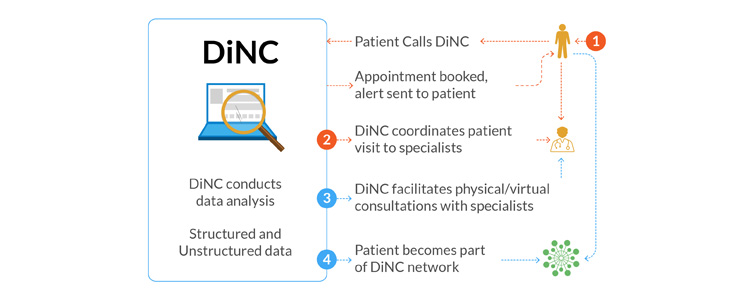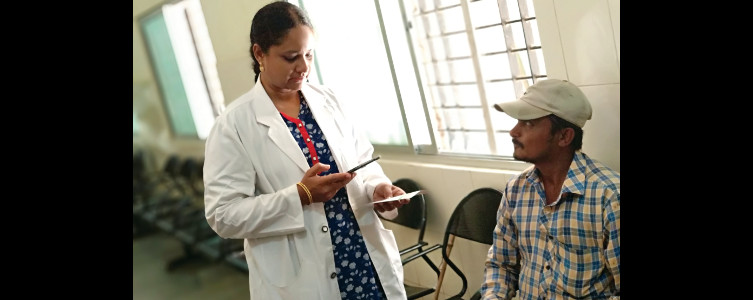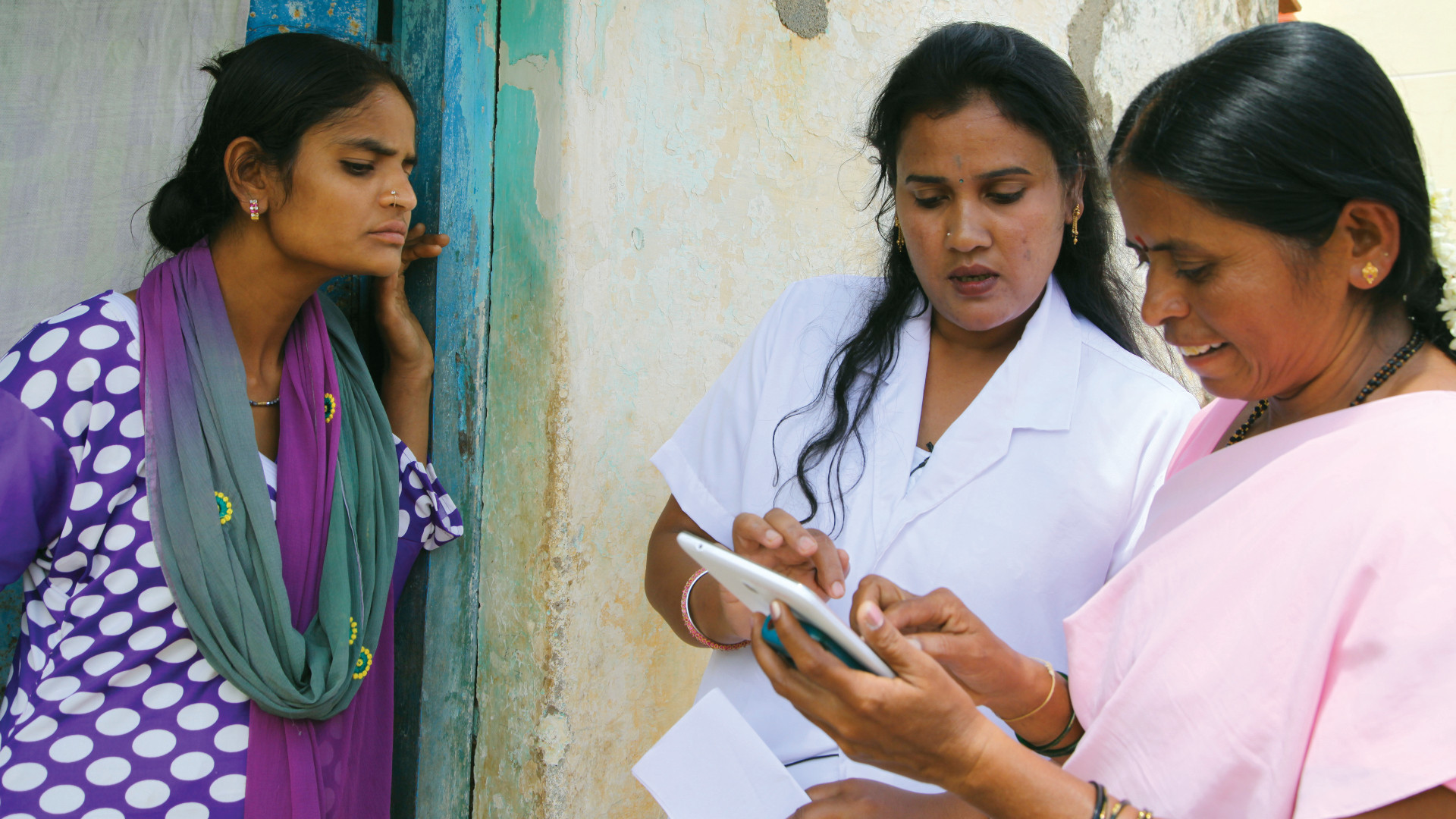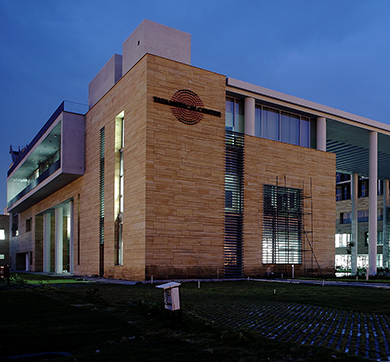September 2018 | 1268 words | 5-minute read
Up until February 2017, Munirathnamma of Gajaladimme village in the Kolar taluka of Karnataka — who is an ASHA (accredited social health activist) — would be swamped with paper work related to patient follow ups, hygiene camps, vaccination drives, and HIV and TB surveys, along with attention to updating her clinical knowledge. But not anymore.
Today, with the DiNC (Digital Nerve Centre) app on her smartphone, she is connected to healthcare centres and to the DiNC at the grass-root level, allowing her to promote healthcare plans such as mother and child care activities, immunisation drives in local communities and maintaining appointments and information, thereby reducing paperwork.
As the first DiNC doctor in Karnataka, Dr Ashwathi Vajith’s scope of work has expanded from reviewing patient records at a tertiary care hospital to providing clinical and non-clinical guidelines for all DiNC centres across India. With the app in hand and her medical degree in place, she says her job is both challenging and satisfying — challenging because she now coordinates across all DiNC centres and satisfying because she gets to help patients from the remotest villages in India.
Dr Vasanth Kumar, nodal officer for DiNC in Kolar and taluka health officer of the district, has worked in the public health department space for over a decade, but the impact he has witnessed in healthcare accessibility and delivery in the last six months has been stupendous. “I was sceptical in the beginning,” says Dr Kumar, adding, “In the last four months, however, we have experienced a huge change in the way services such as mother and child care, treatment of non-communicable diseases and virtual consultation are delivered and received, resulting in efficient healthcare coordination.” He adds, “By adding the public health insurance scheme to the platform, patients from the remotest areas are also able to access affordable treatment.”

Data Saves The Day
TCS’s Digital Nerve Centre is a unique and innovative care delivery model designed to connect, communicate, coordinate and deliver care by leveraging people, infrastructure and a robust digital platform.
Digital technologies are an inseparable component of DiNC where contextual data sharing is enabled to effect care delivery. Its unique and patented approach to combining structured and unstructured patient data helps generate a unified patient view for better and enhanced care. The HealthX component of DiNC is a scalable and robust platform, which has interfacing capabilities with hospital / laboratory / radiology information systems across varied technologies. Phygital resources trained and certified in HealthX platform become the critical success factor in DiNC’s implementation worldwide. The plethora of apps enable care providers to connect seamlessly with patients and expedite care coordination.
The data aggregator component, CDR (clinical data repository), consolidates large-scale, patient-centric, structured and unstructured clinical data from multiple hospital systems. With the aggregation of data from a cluster of cancer hospitals, DiNC already has a comprehensive oncology data repository. More clinical specialisations and domains are being researched and codified in partnership with other hospitals.
The extremely short adoption-and-run cycle for CDR allows flexibility and agility in aggregation of data and facilitates continuum of care. This has huge applicability in patient treatment, public health management, clinical or cancer research and innovation in healthcare systems.
With increased automation and emphasis on digitisation, Indian healthcare is well positioned to reap huge benefits from DiNC and usher in higher standards of care and innovation in healthcare.
1 Doctor, 1,600 Patients
Ranked an abysmal 145 among 195 countries on the Healthcare Access and Quality Index, and with a doctor-patient ratio at 1:1600, India’s healthcare system is overstretched, under-resourced and encumbered. DiNC — the collaborative care enablement solution from Tata Consultancy Services (TCS) and Tata Trusts — with its one-stop solution for care seekers, doctors and healthcare delivery is aimed at changing that.
Launched in early 2018 in Karnataka, Telangana and Himachal Pradesh, DiNC is a patient-centric, service-led healthcare service delivery solution with real-time digital communication for all levels of healthcare within the state healthcare machinery.

It is founded on the backbone of a phygital framework, aimed at delivering compassionate healthcare through use of technology. While the physical aspect of deploying patient care coordinators (PCCs) at public health centres and clinicians at the nerve centre leverages the human element of enabling patient care, the digital backbone leverages mobile and network connectivity to provide accessible care. It makes treatment accessible, timely and precise.
“DiNC is designed to enhance the patient-to-doctor ratio plaguing India’s healthcare sector. It operates within the existing ecosystem to provide a holistic solution benefitting both the urban and rural health system,” says Girish Krishnamurthy, vice president (healthcare products and platform), TCS.
He adds, “With a 55 percent rise in the number of patients availing primary health facilities through the DiNC-enabled public health system, primary care transformation has improved remarkably. Traditionally, ensuring proper mother and child care and treating non-communicable diseases were a major challenge in the public health system. The DiNC model has not only delivered care in these areas but also improved the care continuum and deepened care coordination. DiNC ensures that the right patients are directed to appropriate healthcare facilities for treatment, resulting in improved availability in care and reduction in cost of care delivery.”
In urban health centres, DiNC ensures certainty of doctor consultation through transformative concepts like floating human helpdesks and multiple appointment booking channels. In rural health centres, it helps to transcend the issue of patient-doctor ratio by leveraging technology to deliver services like virtual consultation. It is sustainable, scalable and customisable.
Cancer Care
DiNC was first embraced by a cluster of cancer hospitals in the country, to enable delivery of comprehensive cancer care service. Functional for a year now at four premier cancer hospitals — Tata Medical Center, Kolkata; Adyar Cancer Institute, Chennai; Tata Memorial Hospital, Mumbai; and Regional Cancer Centre, Thiruvananthapuram — it has helped more than 23 lakh patients and provided over 2-lakh hours of patient care.
With the learning and benefits from implementation at these cancer hospitals, DiNC only needed a slight ‘tweaking in language and region-specific requirements’ before it was officially launched.
Studies show that barriers to healthcare delivery across continents are similar in nature. Despite decades of developing health infrastructure, ‘Health for all’ is still far from a reality. DiNC strives to bring efficiency to public healthcare by an innovative combination of people, technology and process.

“DiNC is a transformative platform that aims to fill gaps in patient data and patient navigation to make healthcare delivery seamless and patient friendly. Unlike traditional business sectors, the development sector is still in its nascent stages in terms of using data for effective programming. Most programmes rely on sample surveys, with little real-time actionable insights. DiNC aims to address this challenge by systematic collection and processing of data. This can make healthcare delivery more proactive and customer-centric,” says Abhishek Poduri, head, special projects, Tata Trusts.
Impact
In just over six months, DiNC has brought more than 5 lakh patients under the ambit of DiNC primary healthcare transformation. In all, it has been able to reach out to more than 60 lakh people at multiple levels of the public health system across primary and tertiary sectors.
The individual growth potential through DiNC cannot be overlooked either. For those in healthcare sector, it is an opportunity to work in a professional setup while serving the community. By taking away nonclinical activities from medical professionals, it leads to more efficient use of the clinical workforce while creating new administrative jobs.
“From time to time, the Tata group’s contribution towards nation-building has deeply impacted the country socially and economically,” says Jagat Prakash Nadda, Union Minister of Health and Family Welfare. “The launch of the DiNC is a new beginning in strengthening the healthcare capabilities of the country.”
—Sanghamitra Bhowmik








